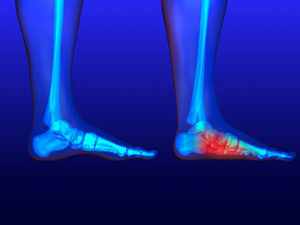Featured Articles
Flat Feet
Flatfoot is a foot condition in which the arch of the foot has either partially or totally dropped or has never developed. While it is common in babies and small children, it can become a problem for them in adulthood if the arch never forms. For adults, the development of flat feet can be brought upon by injury, as a result of pregnancy due to increased elasticity, or obesity. Those who have health concerns such as rheumatoid arthritis or diabetes may also be at greater risk for developing the condition.
If you suspect that you have flat feet, it is best to consult your podiatrist. Your foot doctor will examine the suspected foot and observe how it looks while you sit and stand. He or she may take an X-ray to determine how serious the condition is. Some common signs of flatfoot include toe drift, in which the toes and front part of the foot point outward, a short Achilles tendon, and a heel that tilts outwardly while the ankle tilts inward.
Once flatfoot has been diagnosed, your podiatrist may suggest one of several treatment options. Flat feet can be rigid, in which the feet appear to have no arch even when the person is not standing; or flexible, in which the person appears to have an arch while not standing, but once standing the arch disappears. Those with flexible flatfoot may be told to reduce any activities that cause pain and to avoid extended periods of walking or standing. Another suggestion may be weight loss, as excessive weight may be placing pressure on the arches
In few cases, if the condition is severe and all other methods have been exhausted surgery may be required. This is normally avoided, however, due to a lengthy recovery time and high cost.
What Are Flat Feet?
 If you have noticed the absence of arches in your feet, you may have a condition that is referred to as flat feet. This can be observed when the foot is placed on the ground, and the entire foot touches the surface. This ailment may also be referred to as fallen arches, and most babies are generally born with flat feet. The arch will gradually develop as the child begins to walk, and will generally be fully formed in the teenage years. Adults who have existing medical conditions may have developed flat feet. These may include diabetes, obesity, or rheumatoid arthritis. Additionally, flat feet may develop if you have sustained an injury to your ankle. If you have this condition and are experiencing foot pain, it is advised to speak with a podiatrist who can properly diagnose flat feet and can offer correct treatment options.
If you have noticed the absence of arches in your feet, you may have a condition that is referred to as flat feet. This can be observed when the foot is placed on the ground, and the entire foot touches the surface. This ailment may also be referred to as fallen arches, and most babies are generally born with flat feet. The arch will gradually develop as the child begins to walk, and will generally be fully formed in the teenage years. Adults who have existing medical conditions may have developed flat feet. These may include diabetes, obesity, or rheumatoid arthritis. Additionally, flat feet may develop if you have sustained an injury to your ankle. If you have this condition and are experiencing foot pain, it is advised to speak with a podiatrist who can properly diagnose flat feet and can offer correct treatment options.
Flatfoot is a condition many people suffer from. If you have flat feet, contact Dr. Luz Colon from Absolute Foot & Ankle Specialists Inc.. Our doctor will treat your foot and ankle needs.
What Are Flat Feet?
Flatfoot is a condition in which the arch of the foot is depressed and the sole of the foot is almost completely in contact with the ground. About 20-30% of the population generally has flat feet because their arches never formed during growth.
Conditions & Problems:
Having flat feet makes it difficult to run or walk because of the stress placed on the ankles.
Alignment – The general alignment of your legs can be disrupted, because the ankles move inward which can cause major discomfort.
Knees – If you have complications with your knees, flat feet can be a contributor to arthritis in that area.
Symptoms
- Pain around the heel or arch area
- Trouble standing on the tip toe
- Swelling around the inside of the ankle
- Flat look to one or both feet
- Having your shoes feel uneven when worn
Treatment
If you are experiencing pain and stress on the foot you may weaken the posterior tibial tendon, which runs around the inside of the ankle.
If you have any questions please feel free to contact our office located in Miami, FL. We offer the newest diagnostic and treatment technologies for all your foot and ankle needs.
Read more about Flat Feet





